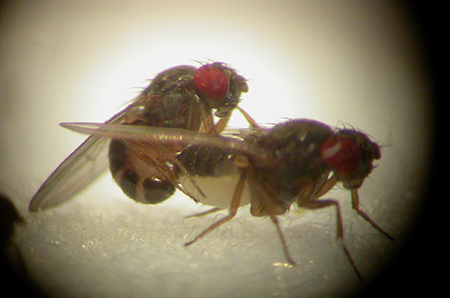
Female fruit flies with a large number of sexual partners are playing an invaluable role in preventing the extinction of males, research at the University of Liverpool has shown.
Scientists have found that flies in the northern parts of the United States are more inclined to have multiple partners in order to reduce the occurrence of an X chromosome which causes the production of only female offspring.
Selfish genetic element
This selfish genetic element (SGE) tries to replicate itself by killing sperm that carry the Y chromosome, but has the side-effect that males with the gene produce fewer sperm. Female fruit flies take advantage of this weakness by having several mates, increasing the chances that SGE-free males, with a higher sperm count, will father their offspring.
The team, in collaboration with the Universities of Exeter, Leeds and Madrid, proved a correlation between the number of mates and the prevalence of the gene by collecting samples of fruit flies from seven sites in the United States.
Evolutionary biologist Dr Tom Price from the University’s Institute of Integrative Biology said: “If this particular SGE was to spread to every male in a population, then no more males would be born, and the population, or even the whole species, would become extinct.”
Dr Price tested this theory in the lab with the flies captured in the USA and found that when females were only allowed to mate once, the SGE spread rapidly enough through populations to drive them extinct in only nine generations.
However, although southern females could have multiple partners, flies captured in northern areas were much more likely to mate more often. They were also prepared to mate again much more quickly than southern flies. Put together, this behaviour was more effective at limiting the spread of the SGE.
Developed mechanisms
Dr Price concluded: “There are a large number of these SGE genes in many organisms, which selfishly increase their own success while damaging the health of individuals and the species as a whole, but in this case the flies have developed mechanisms to limit their impact.
“Females with a high sex drive and males with a high sperm count are keeping this species going.”
The paper, ‘Does Polyandry control population sex ratio via regulation of a selfish gene?’ was published in the journal, Proceedings of the Royal Society.